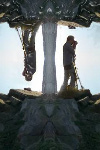© 2005 Iñaki Rezola, All Rights Reserved.
Most water on Earth is salty, making up our Blue Planet's seas and oceans.
Although oceans fill the three fifths of our Earth's surface, they still remain quite unknown to scientists: one can almost say they know a lot more about Mars's surface than about the abyss depths of our seas.
Poorly known of and worse treated, oceans have become endangered systems nowadays: pollution of all kinds, species about to disappear due to overfishing -will there still be whales in the XXII century?-, rising temperatures, etc.
That's why raising general awareness for a better preservation of our oceans becomes imperative. In this task, educative institutions as Aquariums and Sea museums of all kind become an imperative need.
The pano was taken at the Aquarium in Donostia-San Sebastian, where I live ( more information -english included- at http://www.aquariumss.com ). It was the first natural science museum to be built in Spain and it opened in 1928.
La mayor parte del agua existente en la Tierra es salada y se encuentra en los mares y océanos de nuestro Planeta Azul.
Los océanos constituyen las tres quintas partes de la superficie terrestre, pero continúan llenos de enigmas para la ciencia: casi sabemos más acerca de la superficie de Marte que sobre las profundidades abisales.
Mal conocidos y aún peor tratados, los mares forman parte de los sistemas amenazados: polución de todos los tipos imaginables, especies al borde de la extinción como consecuencia de la sobrepesca -¿seguirá habiendo ballenas en el siglo XXII?-, aumento general de las temperaturas, etc.
Por ello es cada vez más urgente aumentar la concienciación general en favor de una conservación integral de nuestros océanos. En esta tarea instituciones educativas como Aquariums y Oceanarios cobran un protagonismo y relevancia especiales.
La panorámica muestra el Aquarium de Donostia-San Sebastián, donde yo vivo (más información en http://www.aquariumss.com ). Fue el primer Museo de Ciencia Natural construido en España y abrió sus puertas en 1928.
Una anécdota sobre la pano: cuando fui temprano por la mañana a sacar las fotografías -antes de la apertura al público para evitar aglomeraciones en el túnel- ¡los peces estaban aún 'durmiendo'! El sistema de iluminación imita el ciclo natural del día y la noche: las luces se encienden y apagan poco a poco. Tuve que esperar casi una hora hasta que acabara de amanecer para poder hacer la panorámica!
Lurreko ur gehiena gazia da, itsaso eta ozeanoak osatzen dituela.
Ozeanoek gure Planeta Urdinaren azaleraren hiru bostenak osatzen badituzte ere, oso ezezagunak dira: ia esan daiteke zientzilariek Marteko azalerari buruz ozeanoen fondo abisalari baino gehiago dakitela.
Gaizki ezagutuak eta are okerrago tratatuak daudela, gure itsasoak egoera larrian daude: mota guztietako kutxadurak, goraka doazen tenperaturak, gehiegizko arrantzaren ondorioz desagertzeko zorian dauden espezie mordoak (lehen baleak, duela gutxi bixigua, orain antxoa... arrain handirik egongo al da gure itxasoan XXII mendean?), etab.
Honexegatik bihurtu da lan garrantzitsu beraiek kontserbatzeko beharraren ohartzea piztea. Betebehar honetan, Aquarium eta mota guztietako Itxas Museoek zer egin handia dute.
Panoramika honek erakusten du Donostiako Aquariumaren Ozeanarioa (informazio gehiago aurkituko duzu http://www.aquariumss.com helbidean. Baita euskeraz ere, noski). Estatu osoko lehen Natur Zientzien museoa izan zen, 1928an ireki zelarik.
Pasadizo bat panoramikari buruz: argazkiak egitera goizean goiz joan nintzela, (museoa bisitariei zabaldu baino lehen, tunelean jende multzo handirik ez aurkitzekotan), arrainak oraindik lota zeuden! Argiek egunsentia eta ilunabarraren pixkanakako piztu-iluntzea imitatzen dute. Zai egon izan behar nuen ia ordubete osoz -erabat argitu arte- panoramikarako argazkiak ateratzen hasi ahal izateko!
I have to say that this shooting was the least eventful of all my WWP's contributions, so there is nothing very particular to be told. But there is always a little something... curious, or whatever. See.
The Aquarium receives often groups of students and is in itself a big tourist attraction, so it can get quite crowded, and the main attraction, the highlight, is of course the tunnel I wanted to show. So I decided to do my shooting early in the morning, before visitors are allowed in. I took the tripod and the rest of my stuff and headed for it. And then... all was allmost dark there! It was still nightime inside. I was explained then that they have got a light system that mimickes sunrise and dusk so as the animals living in have the most natural-like possible environment. Lights are turned on and faded out gradually. As a result, I had to wait for almost an hour until night turned to full day and the first visitors came in!



 Tap or click the zoom icon in the bottom right corner of the picture to switch between in-page and fullscreen view
Tap or click the zoom icon in the bottom right corner of the picture to switch between in-page and fullscreen view